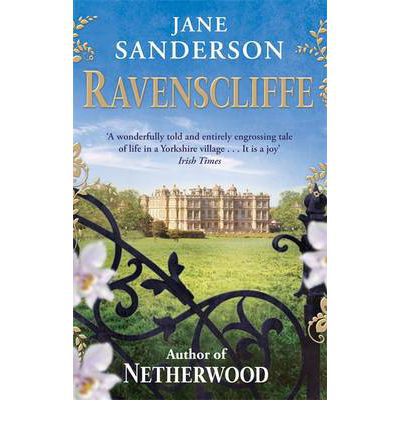First published in October 2012.
Ravenscliffe is the standalone sequel to Jane Sanderson’s debut novel, Netherwood. The novel has been publicised as ‘perfect for readers of Kate Morton and Rachel Hore, as well as fans of period dramas like Downton Abbey.
 Ravenscliffe opens in Yorkshire in 1904, in a small town named Netherwood. The story begins with a very well written description of the mining town, with its ‘spiteful, unruly gangs of hawthorn’ and its three major collieries. The main protagonists of the novel, Anna Rabinovich and Eve Williams, are introduced almost immediately. The two women are looking at Ravenscliffe, ‘the only property on the common, a large, detached villa, deeper than it was wide’. Anna, a twenty-two-year-old Russian émigré, has set her sights on living in the property, which ‘held the promise of happiness… there was warmth here’. Eve, rather older than Anna and with three young children, is a widower, still secretively mourning her late husband Arthur who was killed in a mining accident.
Ravenscliffe opens in Yorkshire in 1904, in a small town named Netherwood. The story begins with a very well written description of the mining town, with its ‘spiteful, unruly gangs of hawthorn’ and its three major collieries. The main protagonists of the novel, Anna Rabinovich and Eve Williams, are introduced almost immediately. The two women are looking at Ravenscliffe, ‘the only property on the common, a large, detached villa, deeper than it was wide’. Anna, a twenty-two-year-old Russian émigré, has set her sights on living in the property, which ‘held the promise of happiness… there was warmth here’. Eve, rather older than Anna and with three young children, is a widower, still secretively mourning her late husband Arthur who was killed in a mining accident.
The second chapter of the novel then focuses upon Clarissa Hoyland and her husband Teddy, otherwise known as Lord and Lady Netherwood. Clarissa is a ‘beautiful, pouting, manipulative’ woman who tends to have tantrums if she is not given her own way immediately. Lord and Lady Netherwood’s kitchen staff are also featured in the narrative. This technique is reminiscent of Downton Abbey and similar period dramas, as the reader is able to see both sides of the same situation.
Many more characters are included throughout the book, both in the main plot and subplots. At first, the sheer number of people who have been introduced into Ravenscliffe seem overwhelming, and it is consequently difficult to make sense of who is who and what relevance they have to the rest of the story. We meet Eve’s partner, Daniel, her three children and her brother Silas, as well as an Amos Sykes, a Jem Arkwright and an Absalom Blandford in just the first few short chapters.
Many period details have been included by the author, ranging from the exact model of the stove in Ravenscliffe’s kitchen to a game called ‘knur’, and from the growing awareness of mining conditions to the responsibilities of head gardeners in the Edwardian era. Changing times in history have been included, along with important real-life figures – Keir Hardie, the King of England and Sylvia Pankhurst, for example – alongside Sanderson’s fictionalised creations. Relationships between the characters simultaneously move forward and dissipate, new alliances are formed and long-lost siblings are found and rejoiced over. The divide between wealth and relative poverty has been touched upon, as has the rather rigid class system which existed at the time.
Sanderson has used a third person perspective throughout, in a style which feels rather informal. The dialogue of many of the characters – in fact, the majority of them – is written in Yorkshire dialect. This works well to an extent, but it does feel rather overdone at times, particularly when entire conversations which fill pages at a time follow the exact same patterns of speech. Sanderson’s scenic descriptions are rich and often vivid, but sadly not much is made of what the characters themselves are like. Descriptions of them seem to have been overlooked somewhat, and they feel a little flat and rather two-dimensional in consequence. We do learn some details about their personalities as the story unfolds, but there is no real creation of a coherent and consistent work. Due to the lack of character descriptions and the similarities in the dialects which many of the characters speak with, it is difficult at times to distinguish between one character and the next.
Ravenscliffe itself is certainly stronger with regard to its storyline than with the characters which it involves. Many different plots converge to make up the overall story, and in this way, Ravenscliffe is rather deftly crafted.
Ravenscliffe is an interesting story on several accounts, and Sanderson’s use of social history is its definite strength. The story is a little confusing at times, merely due to the sheer numbers of characters involved from one chapter to the next. The novel does not break new ground by any means, but for readers of historical fiction, the book is a pleasant one. It does seem rather difficult for the reader to become caught up in the story, however, and no real compassion is built up on behalf of the characters.
Purchase from The Book Depository
Advertisements Share this:




